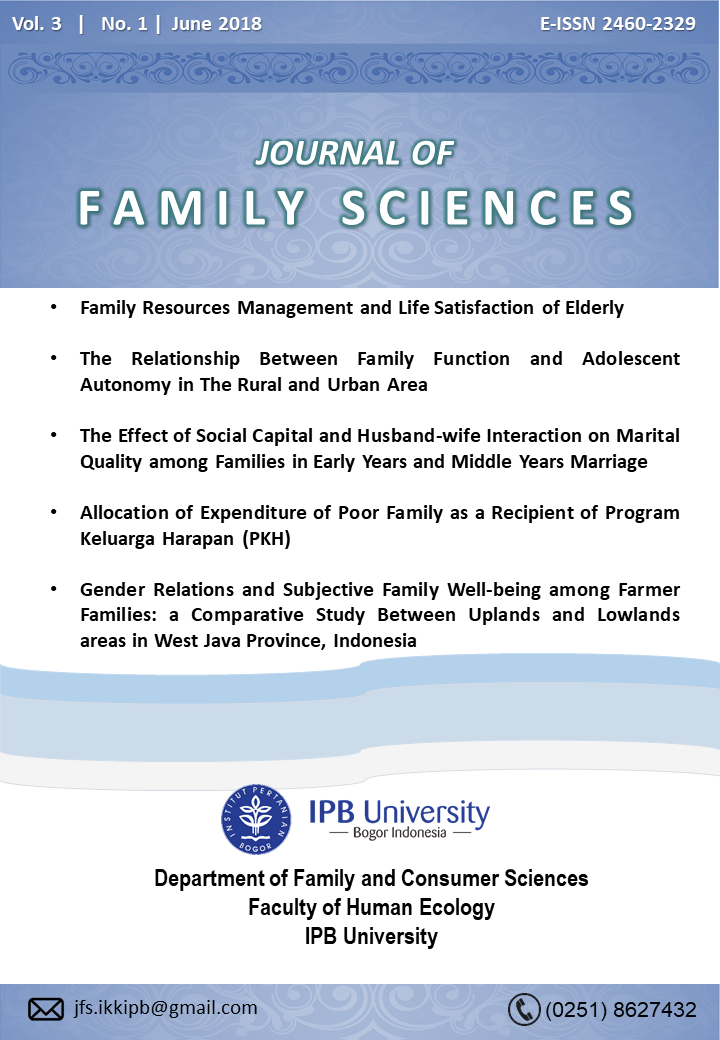The Relationship Between Family Function and Adolescent Autonomy in The Rural and Urban Area
Abstract
This study aims to analyze the function of families in urban and rural areas as well as its relationship with adolescent autonomy by using cross sectional study method. The data collection time was conducted in September 2016. By proportional random sampling method, there were 72
samples at SMPN 2 Bogor (representing urban area) and 72 people at SMPN 2 Parung (representing rural area). Research data includes family characteristics, family functions divided into 3 dimensions (10 sub-scales) and adolescent autonomy consisting of 3 dimensions (value, emotional and behavioral). To see the correlation, the Pearson Correlation test was used and to see
differences in family function characteristics and gender-based autonomy was seen by the Independent T-test differential test. The results showed that the average score of family function in urban areas was 118.44, while in rural areas 121.12. This shows the function of families in rural
areas better than in urban areas. The average score of urban adolescent autonomy is 81.21, while in rural areas it is 77.29. This difference is significant at 99% confidence level. Adolescent autonomy is positively correlated with family function of personal growth dimension with correlation coefficient of 0.207 (at 95% confidence level). This shows that the better family
function then the better the adolescent autonomy.
Downloads
References
Fleming, M. (2005). Gender in Adolescent Autonomy: Distinction between Boys
and Girls Accelerates at 16 years of Age. University of Porto.
Garber, J., & Stephanie A. (2001). Emotional Autonomy and Adolescent
Adjustment. Journal of Adolescent Research Vol 16
Gunarsa, S.D., & Gunarsa, Y.S.D (2006). Psikologi Perkembangan Anak dan
Remaja. Jakarta: PT BPK Gunung Mulia.
Handayani, F. (2004). Some Factors Associated with Types of Parenting by the
Father and Emotional Intelligence of School Children. Thesis Department
of Family and Consumer Science. Department of FEMA-IPB.
Karabanova, O.A., & Poskrebysheva, N.N. (2013). Adolescent Autonomy in
Parent-child Relations. Social and Behavioral Sciences 86 (2013) 621-628
Martiastuti, K. (2012). Resilience of Adolescent based on Gender, Type of
School and Regional Typology. Bogor. Institut Pertanian Bogor.
Monk,F.J., Knoers, A. M. P. & Haditono, S. R. (2001). Developmental
Psychology: Introduction in Different Parts. Yogyakarta: Gadjah Mada
University Press.
Moos, R. H., & Moos, B. S. (2002). Family environment scale manual.
Consulting Psychologists Press
Rahmawati, H.S. 2005. Differences of independence between the Firstborn and
the youngest child in second grade students of SMA Negeri 11 Semarang
in the Lesson 2004/2005. Essay. Guidance and Counseling Department.
FIP. UNNES.
Ruhidawati, C. (2005). The Influence of Patterns of Parenting, Peer Groups and
Youth Activity on Independence. Unpublished thesis. Department of
FEMA-IPB.
Steinberg, L. (1993). Adolescence-Third Edition. New York: McGraw-Hill, Inc.
Borkowsky, J., Ramey, S., & Bristol-Power, M. (Eds.). (2002). Parenting and the
child’s world: Influences on academic, intellectual, and social-emotional
development. New York: Springer Science.
Mahwah, NJ: Lawrence Erlbaum as cited in Hair, E., Moore, K., Garrett, S.,
Kinukawa, A., Lippman, L. & Michelson, E. (2005). The parentadolescent
relationship
scale. In K. Moore & L. Lippman (Eds.) What do
children need to flourish (pp. 183-202).
Hair, E., Moore, K., Garrett, S., Kinukawa, A., Lippman, L. & Michelson, E.
(2005). The parentadolescent relationship scale. In K. Moore & L.
Lippman (Eds.) What do children need to flourish (pp. 183-202). New
York: Springer Science.
Parker, J., & Benson, M. (2004). Parent-adolescent relations and adolescent
functioning: Self-esteem, substance abuse, and delinquency. Adolescence,
(155): 519-530.
Resnick, M., Ireland, M. & Borowsky, I. (2004). Youth violence perpetration:
What protects? What predicts? Findings from the National Longitudinal
Study of Adolescent Health. Journal of Adolescent Health, 35(5): 424e1424e10.
Sprinthall, N.A., & Collins, W.A. (1984). Adolescent psychology: A
developmental view. Reading, MA: Addison-Wesley
Authors who publish with this journal agree to the following terms:
- Authors retain copyright and grant the journal right of first publication with the work simultaneously licensed under

This work is licensed under a Creative Commons Attribution 4.0 International License. that allows others to share the work with an acknowledgement of the work's authorship and initial publication in this journal. - Authors are able to enter into separate, additional contractual arrangements for the non-exclusive distribution of the journal's published version of the work (e.g., post it to an institutional repository or publish it in a book), with an acknowledgement of its initial publication in this journal.
- Authors are permitted and encouraged to post their work online (e.g., in institutional repositories or on their website) prior to and during the submission process, as it can lead to productive exchanges, as well as earlier and greater citation of published work (See The Effect of Open Access).



_001.png)



